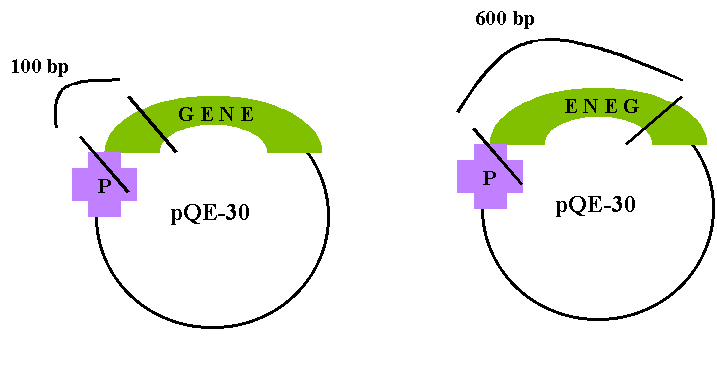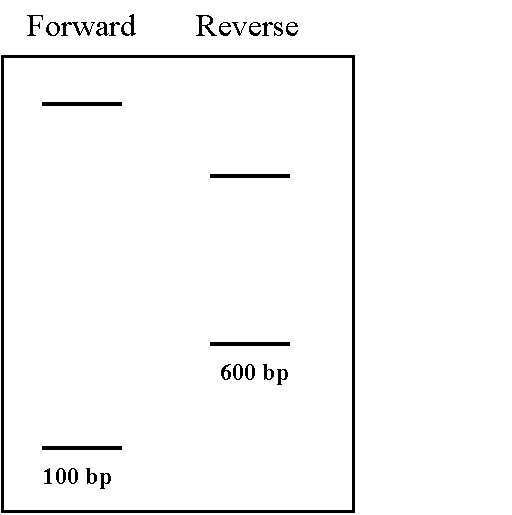This web page was created as an assignment for an undergraduate course at Davidson College.
Experimental Design
The experiment designed to clone the IDH genes into a vector is outlined in the lab schedule and is more specifically detailed in the transformation protocol. We used the pQE-30 UA vector supplied by Qiagen. This vector is an expression vector, which allows the cloned piece of DNA to be translated and expressed in bacterial cells, using those cells' machinery for translation.
However, there are two ways in which the piece of DNA could have been inserted into the vector: a "forward" or a "reverse" orientation, as shown below in Figure 1:

Figure 1: The pQE-30 vector containing the "forward" (left) and "reverse" (right) orientation of the inserted gene. Green represents the insert and purple is the promoter.
Because the correct orientation (the "forward" direction) is needed for the expression of the protein, we only want to work with vectors that contain the insert in the correct orientation. But how can we test for this without trying to make the protein?
Each gene contains several 6-base sequences that are recognized by specific restriction enzymes. You can see the restriction maps of each gene: IDH1, IDH2, IDP1, IDP2, and IDP3. These restriction enzymes recognize the sequence and work to cleave the DNA in that location at an optimal pH and salt concentration. We must find restriction enzymes that can cleave both the insert and the vector itself. The key to this is finding an enzyme that only cleaves the insert once and the vector once. When cleavage occurs, we will have two different sized pieces of DNA. By knowing the exact location of the cleavage, we can determine whether the insert had the correct orientation (see Figure 2).

Figure 2: When the gene is inserted in the forward direction (left), a piece 100 bp long will be produced. If the gene is inserted in the reverse direction, then a piece of DNA that is 600 bp long will be produced. (Green = gene; purple = promoter)
Gel electrophoresis will be used to determine which orientation is correct (see Figure 3).

Figure 3: Gel electrophoresis of digested "forward" and "reverse" vectors.
For example, as seen below, IDH1 can be cut by 34 6-base cutter restriction enzymes:
Figure 4: Restiction enzyme map of 6-base cutters for the yeast IDH1 gene
The red and blue lines represent the exact locations where the enzymes cut, and as you can see, some of the enzymes cut in more than one place. This would just make our job more difficult, so it is beneficial to only consider those that cut the insert once. Of these, we must choose those that our lab has available (BamH I, Bgl II, Cla I, EcoR I, EcoR V, Hind III, Kpn I, Pst I, and Sal I) and of those, which will cut the plasmid once (BamHI, Bgl II, EcoR V, Hind III, Kpn I, Pst I, and Sal I). Only two enzymes will effectively cleave the insert and the plasmid: EcoR V or Sal I. Thus, we will use EcoR V for IDH1. IDH2, IDP1, and IDP2 can all use Bgl I. Bgl I does not have any sites in the IDP3 gene and no other restriction enzymes cut both the plasmid and the IDP3 gene. Therefore, we will digest the vector with Bgl I and Cla I, which will cut the gene only once, but will not cut the plasmid. We will still get the same result (two separate pieces of DNA) as if we had cut the vector with only one restriction enzyme that cut both the vector and the insert. To see the actual lengths of the expected "forward" and "reverse" pieces of DNA for each gene, click here. The restriction digests will be set up according to the digestion protocol.
Once we have vectors containing the insert in the correct forward orientation, we can see if the protein was expressed. Each gene will produce its own protein, fused with the RGS-6xHis tag from the expression vector. The amino acids of the fusion proteins can be seen here.
Now we have successfully cloned the IDH genes!
Return home
Go back
Return to the Molecular Biology Homepage
© Copyright 2002 Department of Biology, Davidson College, Davidson NC 28035
Send comments, questions, and suggestions to vistatler@davidson.edu
